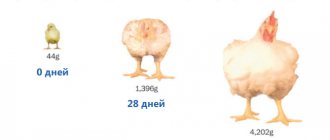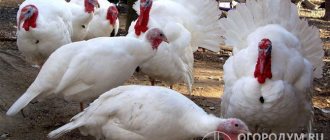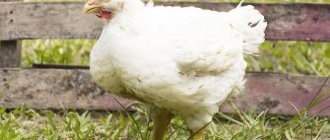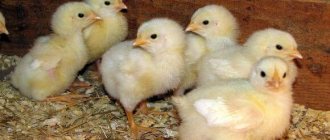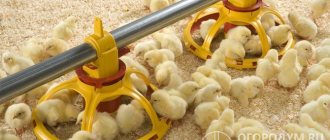Inexpensive and high-quality meat for your own needs or for sale can be obtained by raising broilers. If there are unused rooms on the site, they can be used by doing a little modernization. Raising broilers at home for beginning farmers requires special knowledge: how to choose the right breed or line, provide adequate nutrition for a certain type of chicken, what conditions and regimes are needed during different periods of chicken growth. These issues are discussed in detail in the following article.
Features of cultivation
To raise broiler chickens, poultry houses use two main methods - intensive and extensive. Which one is better to choose depends on the availability of free space for keeping the bird.
Intensive
The intensive method involves raising chicks in cages in a limited space. This way the bird moves less and, accordingly, gains weight faster. You can do without a cage - the movements of the chickens are limited to deep floor litter.
Broilers are inactive and phlegmatic, so they are undemanding to the availability of free space. Birds sit in one place for a long time and move only to eat. In intensive rearing, 15-18 chickens are usually placed per 1 m2 of cage. But this is an average. The density of birds depends on age and has the following standards per 1 sq.m.:
- from birth to 5 days - 31-32 pcs.;
- from 5 to 10 days - 23-25 pieces;
- from 10 to 20 days - 18-20 pcs.;
- from 20 to 40 days - 12-15 pcs.;
- 40-55 days − 6-10 pcs.
During intensive rearing, chicks are fed only with industrial compound feeds containing all the substances necessary for a rapid increase in muscle mass.
Extensive
When reared extensively, broilers feel more free. They are kept in an equipped chicken coop. In the warm season, young animals are released outside for grazing.
To protect young animals from attacks by rodents, cats and other animals, the walking area is fenced with a chain-link mesh. This method is considered more humane, since the chicks feel freer.
Extensive rearing involves 10-12 chicks per 1 m2 of poultry house. Chickens are fed not only with prepared feed, but also with natural food.
Appearance
Broiler chickens compare favorably with chicks of the same age of conventional breeds. The first ones, by the age of one and a half weeks, are able to gain up to 1.5 kilograms of live weight, while ordinary chickens gain no more than half a kilogram. The weight of an adult chicken of hybrid breeds reaches 4 kilograms, and the weight of some cockerels is 5.5.
Broiler chickens have a rather compact body, short legs and wings. The bird is inactive, has a calm disposition and a phlegmatic character. The color is most often white, like the plumage of the parents.
How long does it take to grow
Chickens of meat breeds grow quickly. Every day their weight increases by 30-80 grams. Therefore, novice farmers try to raise young animals for as long as possible so that the birds gain more weight. But this will not bring the desired result. Broiler chickens grow on average up to 2 months. Upon reaching this age, their body weight remains unchanged.
Thus, keeping broilers for a long time is not advisable. The bird has to be fed continuously, spending significant amounts of money on its nutrition. But at the same time the chicken stops growing.
Breed selection
Typically, chickens are purchased from producers who breed them specifically for sale. Many people try to purchase day-old chicks at the lowest cost. But in the first days of life, chicks die most often.
Therefore, sometimes it is wiser to take young animals 10 days old . It is better to purchase chickens at hatchery stations in poultry farms.
You need to choose lively, active chickens with shiny, clear eyes. To distinguish between cockerels and hens, you need to spread the chicken's wing. Cockerel feathers are the same length, hens' feathers are different.
A healthy chick is distinguished by a soft and toned tummy, even fluff, and clean buttocks. Their wings should be pressed to the body. But for some breeds of broilers (“Cobb 500”, “ROSS-308”) a slightly enlarged belly, a bluish tint to the legs and beak are a common occurrence.
Normally developing chicks always respond to sound. When you tap on the box where they are located, the chicks are drawn towards the noise.
Chickens of meat crosses “Dominant”, “Smena”, “Avian Farms”, “Tibro”, “Tetra”, “Ross”, “Lohmann” are more suitable for home breeding.
A cross is a line of chickens bred with certain properties. Among the crossbred breeds, Adler Silver, Kuchin Jubilee, Rodaylanp, and Plymouth Rock are suitable, but their meat qualities are lower.
The most common meat cross that meets international standards is Smena-7. About half of the broilers raised by domestic poultry farms are bred.
Of the imported broiler crosses, “Cobb 500” and “ROSS-308” are considered the best.
Where to keep broilers
Typically, broilers are kept in 2 main ways - on the floor or in cages. With a large number of poultry, cage housing is more practical - it does not require large areas, and hygiene measures are carried out quite easily. To quickly clean up chicken droppings, the cages are equipped with a tray that collects broiler waste.
In addition to the pallet, additional equipment will need to be provided in the cages. The main elements include:
- special devices for heating and lighting;
- thermometers for measuring temperature inside cells;
- devices for feeding and water supply.
Cages are usually made from galvanized wire with a diameter of 2 mm. To make the floor part, twigs no thinner than 3 mm are required.
Cages can be installed separately or formed into a system of cells grouped by length and height. Experienced poultry farmers prefer to install cages for keeping broiler chickens on 2-3 floors.
Floor keeping is less troublesome; chickens are left to their own devices most of the time. You only need to feed them on time and periodically clean the chicken coop. However, raising chickens on the floor has several disadvantages:
- more free space is required;
- increased costs for heating, lighting and ventilation in the poultry house;
- the need to clean the chicken coop more often;
- rapid contamination of the bird's habitat and, as a result, more frequent diseases.
Despite the listed disadvantages, there is one significant advantage - the young animals feel free and comfortable. A favorable psychological atmosphere during cultivation significantly improves the quality of meat. In broilers kept in the floor method, it is softer and juicier.
Beginner poultry farmers often try to keep broiler chickens in greenhouses. At first glance, this is a good option - the young animals are always warm, even in the cold season. However, in greenhouse conditions it is difficult to organize high-quality ventilation - usually the indoor humidity is 75-85%. In such conditions, chicks often get sick and do not gain weight well.
Origin
Contrary to popular belief, a broiler is not a breed of chicken. This is the common name for the young population of farm birds and animals that are raised to produce cheap meat in large quantities. Broil in English means “spit roasting”. When raising broilers at home, you get more meat from one chicken than from an adult bird of another breed, and it also differs favorably in quality.
The first broiler chickens were bred by English farmers. They crossed two breeds of large chickens and got chickens, which they began to call giants and belong to the larger breed. However, at home, the bird reproduced poorly, and after one generation the chickens turned into the most ordinary ones.
Farmers soon realized that it was only possible to produce large chickens through hybrid means. To create such a bird, the following meat breeds of chickens are most often crossed:
- Cornish;
- langshan;
- fireroll;
- gate;
- Plymouth Rock;
- Dorking;
- Cochin.
Professional breeding of broiler poultry can only be carried out on special farms. Every year, breeders create new hybrid forms, so-called crosses. They inherit the best qualities from their parents: early maturity, high slaughter weight, immunity to various diseases.
Arrangement of the place
Before moving broiler chickens into the chicken coop, you will have to prepare the room. To do this you will need to do the following:
- It is good to disinfect the poultry house. To do this, it is necessary to plaster and cover the walls with lime, and also cover the floor with lime in a ratio of 1 kg per 1 m2.
- Seal all cracks and cracks in the walls to avoid drafts. You should not cover the holes with old rags and other unnecessary things; it is better to plaster them thoroughly.
- Cover the floor with a soft covering 10-12 cm thick. For this you can use straw or small sawdust.
- Install vertical and frontal drinkers and feeders. In this case, the length of the containers must be calculated in such a way that there is no crowding during meals.
- Equip perches. The size of each should be 30-35 cm. The gaps between the perches can be made the same length.
If it is necessary to build a new chicken coop, it is worth considering the standards adopted for raising broiler chickens. It is better to use wood as the main building material. But plywood and cinder block are allowed. The ceiling height should be 1.8-2 m. To protect the livestock from the penetration of small animals, you will need to raise the foundation by 35-40 cm.
Chicken coop - location, materials
When planning to place a chicken coop on your site, it is important to remember that chickens cannot tolerate:
- low temperature,
- high humidity,
- lack of oxygen.
Choose a place with a groundwater level no higher than 1 meter from the ground surface.
- Floor. The concrete base is poured. The floor level is made 20-30 cm above the ground level. Such a base will avoid problems with humidity and prevent gas exchange with the ground. The entrance to the broiler chicken coop is preferably located from the east.
- The walls are usually made of treated wood, brick or blocks, and the blocks are plastered. When breeding at home, wooden chicken coops are often built. Insulation, such as polystyrene, is placed between two layers of boards. The walls should be smooth on the inside - this will make cleaning easier and allow for thorough disinfection.
- Roof. A solid or gable roof is made of wood, PVC or tiles. Sheet metal is less suitable for a roof; it gets very hot in the summer and cools down quickly in the winter. A gutter is installed under the roof.
Conditions of detention
For normal growth and development of broiler chickens, you will need to create comfortable conditions for them. To raise productive broilers you need to do the following:
- Organize optimal temperature conditions. For chickens in the first days of life, the temperature in the poultry house must be maintained at at least 30°C. Cooler conditions are tolerated as they mature. By 2 months the indicator is gradually reduced to 30°C. To maintain the desired temperature, incandescent lamps or heaters are used.
- Maintain lighting level within 2kW/1m2. Once the chicks reach two weeks of age, the level of illumination can be gradually reduced. After 3 weeks, it is necessary to use alternation - 2 hours light / 1 hour dark. This regime is aimed at more intensive food consumption.
- Provide good ventilation. To do this, you can make windows or small holes in the opposite walls of the chicken coop. It is also worth providing plugs to be able to regulate ventilation. The optimal humidity level in a chicken coop ranges from 50-60%.
Prolonged hypothermia of broiler chicks should not be allowed. Otherwise, the chickens will not gain weight well.
It is also necessary to calculate in advance the area of the future poultry house based on the number of chicks planned for rearing. There should be 10-12 birds per 1 m2 when kept on the floor. With cage farming - up to 18 chickens.
How to grow using an incubator
Eggs no older than 3 days are suitable for raising chickens in an incubator. Before placing them in the device, you need to adjust the temperature mode:
- First week. Optimal mode +38.5…+39 degrees. After placement, the eggs must warm up for a day, after which they are turned. Then they move regularly (those from the sides are moved to the center and vice versa).
- From day 19 there is no need to turn over. The temperature should be +37 degrees.
- On the 20th day the chicks will appear. On day 22 they can be pulled out of the incubator.
Expert opinion
Firsov Sergey Arkadevich
Poultry farmer
Note! For hatchery chicks, you need to arrange dimmer lighting.
Broiler feeding
The rate of weight gain by a broiler directly depends on the correct organization of feeding. Therefore, before raising chickens, you should take care in advance of preparing a suitable diet. Basic principles of feeding meat chickens:
- Newly hatched chicks are given pre-start feed before they reach a week of age. Babies are fed at least 8 times a day. If the feeders are emptying quickly, you can feed more often. Each chicken should eat 10-20 grams of feed every day.
- For three-day-old babies, it is recommended to add finely chopped fresh grass and a crushed hard-boiled egg rolled in flour to their diet. Ground grain, cake and fermented milk products (fine-grained cottage cheese, kefir, yogurt) are also allowed. From 6 days the chicks are given starter food.
- Upon reaching 2 weeks, crushed corn is added to the chicks’ menu. At this stage, babies are growing quickly. Therefore, it is necessary to include sources of calcium and other mineral compounds in the diet: shell rock, chalk, lime, crushed eggshells.
- From 3 weeks, young animals are fed boiled potatoes. It is better if the vegetable is grown in your own garden.
- From one month onwards, broiler chickens are transferred to finishing feed. At the same time, their menu is further expanding. For active growth and normal development, young animals are given greens, feed yeast and fat, milk powder, bone meal, blood meal, and fish meal. The chicks are also provided with access to a large amount of ground corn, barley, and millet. Every day, a month-old broiler should eat from 90 to 150 g of feed. The number of feedings is reduced to 3-4 times a day. At this age, the bird is fed most intensively.
- In the period from 1 to 2 months, a standard broiler weighs more than 3 kg. You need to feed the bird 2-3 times a day. At the same time, the amount of finishing feed per head per day is 160-180 g. The menu also includes chopped beet tops and cabbage leaves. This regime is maintained until slaughter.
For better disease resistance, as well as to improve the psychological state of the chickens, upon reaching 5 days they are given special vitamin supplements. For example, Trivit, Tetravit. One of the most inexpensive but useful remedies is fish oil. It strengthens the immune system, activates growth, and promotes the formation of a strong musculoskeletal system in broilers. Vitamins are added to drinking bowls 3 times a week.
In the first hours of life, broiler chickens need to be given water with dissolved sugar. To prepare the solution, mix 1 liter of water and a teaspoon of sugar. This will increase the survival rate of the chicks and give them energy.
Some farmers recommend feeding broiler chickens with wet mash from 3 weeks. Such dishes improve the health of the bird and promote rapid weight gain due to its high calorie content. Example recipe:
- 500 grams of feed;
- 250 ml water;
- 250 ml low-fat meat broth;
- 200 grams of kefir.
It is also allowed to add fresh, slightly dried herbs, boiled vegetables, yeast and kitchen waste to the dish.
Products that are strictly forbidden to be given to broilers deserve special attention. Prohibited foods include:
- sausages;
- fresh milk;
- cheeses;
- candies and other sweets;
- muffins;
- peels from melons and watermelons.
Before slaughter, the broiler is not fed for 6-8 hours, providing unhindered access to water. This is necessary to cleanse the intestines of contents.
Slaughter, plucking and preparation for sale
Young animals can be slaughtered from 2 months of age. When exactly to do this is up to the poultry farmer to decide. It is important to take into account that when the weight of the bird exceeds 2-2.5 kg, its rearing will become unprofitable.
6 hours before slaughter, chickens stop feeding. This allows the stomach to cleanse itself, but it does not affect the taste of the meat in any way. After slaughter, birds should be hung upside down to allow blood to drain.
When the liquid has flowed out, place the carcass on the board and begin plucking. Move in the following sequence:
- Tail.
- Wings.
- Back.
- Breast.
- Neck.
- Legs.
To avoid damaging the skin, you need to pluck a small bunch of feathers.
Chick care
In order for broiler chickens to grow healthy, they must be carefully looked after. Basic care activities include:
- Treating the chicken coop with disinfectant solutions before moving in the young animals. For these purposes, products such as Ecosept or Arquadez are suitable. To prepare the solution, add 250 ml of disinfectant to 1 liter of water. The advantage of such disinfection is that there is no need to rinse off the solution.
- Daily cleaning of feeders and water bowls. It is also necessary to ensure that food and liquids in containers are always fresh. Do not allow food to become sour or rotten. It is best to feed the chicks little by little and add fresh food as the feeders empty.
- Ensuring plenty of drinking water. Broiler chickens drink a lot. The feeling of thirst leads to significant psychological discomfort and reduces the productivity of the bird.
- Adding potassium permanganate to water. This event is held once a week to disinfect the stomachs of young animals. To prepare the solution, just add a little potassium permanganate to the drinking bowls until the liquid turns pale pink. The prepared solution should be in the drinking bowls for no longer than 40 minutes. After this time, you will need to replace it with clean water.
- Organization of a special disinfection mat - a depression in the floor near the entrance filled with sawdust soaked in a disinfectant solution. Thanks to such a mat, chickens entering the chicken coop after a walk, as well as poultry farmers, will not be able to bring pathogens inside.
- Regular cleaning of the inside of the chicken coop. Excessive indoor pollution leads to various diseases and even death of birds. Therefore, once a week it is necessary to carry out general cleaning - remove droppings and change the bedding. And once a month, the walls and floor of the poultry house need to be treated with lime.
- Organization of "bathing" smoking. To clean the feathers, you need to install a large container with fine sand in the chicken coop. In it, the young animals will carry out hygiene procedures. In addition, ingesting small grains of sand helps improve the functioning of the gastrointestinal tract.
When performing the above activities, broiler chickens will feel as comfortable as possible. Therefore, it is worth making efforts to ensure sanitary conditions in the chicken coop.
Cultivation time
If broilers are provided with the necessary care and suitable living conditions, they rarely become infected. After two months, small chickens grow into full-fledged broilers. Such adult chickens weigh about 2 kg. It is not worth growing them even longer, since growth stops, and the appetite only grows.
Finally, you can watch a video about keeping broilers at home.
Chicken diseases
Domestic chickens are susceptible to many dangerous diseases. Therefore, it is necessary to take care of the health of the chickens in advance and talk to the veterinarian about timely vaccination. Most often, chickens suffer from the following infectious diseases:
- Salmonellosis. The infection is spread by insects, rodents, and mealworms. Infection can also occur due to a violation of the temperature regime in the chicken coop, stagnant water or stale food, or unsanitary conditions. Symptoms include weakness, apathy, discharge from the eyes and beak, and profuse diarrhea. If left untreated, the chicken dies in 90% of cases. If a sick individual is detected, it must be immediately isolated from the livestock. After which - treat with antibiotics (Tetracycline, Ampicillin, Enrofloxacin).
- Mycoplasmosis. The disease is transmitted by airborne droplets, through feed and water, from hen to hatched chicks. Mycoplasmosis manifests itself in the form of difficulty breathing, wheezing, inflammation of the mucous membranes, and weight loss. Broiler chickens are more often susceptible to disease due to cramped living conditions. Therefore, for prevention, it is necessary to regularly clean and disinfect the poultry house or cages. The disease is treated with antibiotic solutions (Streptomycin, Levomycytin, Oxytetracycline).
- Pasteurellosis. Chicks are more susceptible to the disease than adults. Pasteurellosis spreads quickly - in 2-3 days about 80% of the livestock falls ill. Therefore, when a sick chicken is identified, it is immediately slaughtered, and the poultry house is thoroughly disinfected. The disease is transmitted by airborne droplets, through the bites of ticks and other blood-sucking insects, and through contaminated food and water. Symptoms include: blue comb and earrings, refusal to eat, wheezing during breathing, and bloody diarrhea. Antibiotics are used for treatment.
- Colibacillosis. The disease develops after E. coli enters the bird's body along with food and drink, as well as the droppings of infected relatives. The disease leads to rotting and gradual death of internal organs. Characteristic symptoms: bluish beak, refusal to eat, severe thirst, gray-green diarrhea interspersed with blood. Sometimes a chicken goes blind. When the disease occurs in an acute form, the bird progresses quickly. The chronic form is treated with the antibiotic Levofloxacin.
- Coccidiosis. The disease leads to damage to the gastrointestinal tract up to complete loss of function. Infection occurs when kept in unsanitary conditions. Symptoms: yellow or greenish diarrhea, lethargy, lack of appetite, weight loss. If there is no immediate treatment, the bird will die. To prevent pathology, the drugs Coccidiovit and Baycox are added to drinking bowls and feeders.
Also, in chickens up to 2 weeks of age, dyspepsia is often observed - a disorder of body functions due to the consumption of stale food. Therefore, the food in the feeders must be constantly changed to fresh. If the chick does get sick, you can improve its health with a solution of glucose and ascorbic acid. Vitamin and mineral complexes will also help.
Keeping Birds Healthy
To prevent rickets, coccidiosis and other dangerous diseases, vitamin and mineral supplements and coccidiostats are included in the diet of growing chickens. To reduce the risk of the spread of intestinal disorders, it is important to keep feeders and drinkers clean. Additionally, it is recommended to feed the chicks from days 5 to 7 with a weak solution of potassium permanganate.
Sick chickens are quarantined so that they do not come into contact with healthy individuals. Pharmaceuticals, including antibiotics, should only be given after consultation with a veterinarian. They are not used at the final stage of fattening to prevent medications from getting into the meat.
Due to the sudden weight gain in broilers, the load on the skeleton increases greatly, so they need more vitamins and minerals. You can introduce each component separately or use complex supplements that include the required set of biologically active substances (BAS).
Common mistakes when raising broilers
Beginner poultry farmers often note that despite following all the rules for rearing, chicks grow poorly and often get sick. In such situations, it is worth paying attention to common mistakes when keeping young animals:
- Feeding chickens from the first days of life with too high-calorie foods. Up to a week, the digestive system of babies is too weak and tolerates specialized food and light meals well. Cereals, cottage cheese and meat flour can significantly worsen the health of young animals.
- Keeping chicks in too spacious a room. To quickly gain body weight, broiler chickens must consume as few calories as possible and, accordingly, lead a sedentary lifestyle.
- Lack of floor temperature control when kept outdoors. By moving on a cold floor, a chicken runs the risk of getting sick. The general health also deteriorates, the bird is in constant stress. Therefore, the floor covering should always be dry and warm.
- Irregular treatment of walls and ceilings with lime. This leads to the formation of mold in the chicken coop. The fungus increases humidity, and its microspores easily enter the respiratory tract of chickens, causing various diseases.
- Organization of excessively bright lighting. For chickens, dim light that does not hit the eyes is considered comfortable. Bright lighting negatively affects the bird's nervous system, making it overly excitable and aggressive.
- Lack of daily ventilation. Often farmers try to keep the chicken coop warm and deliberately skip ventilation. You can't do this. Toxic gases, waste products of chickens, accumulate daily in the chicken coop. Also, lack of regular ventilation leads to increased humidity.
- Savings on vaccinations. Some diseases can affect 100% of the livestock in a matter of days. Therefore, it is better to agree with the veterinarian in advance and vaccinate the young animals. The costs of vaccination are not comparable with the treatment of chickens from diseases or the damage from the death of birds.
- Insufficient attention to the atmosphere inside the chicken coop. Some chickens engage in pecking. If the injured chicken is not separated from other birds in time, it may be pecked to death. The chick's wounds must be treated with brilliant green. It can be returned to its relatives only after complete recovery.
To raise broiler chickens, you will have to put in a lot of effort, as well as finances. However, with the right approach to business, all costs will be repaid in full. The juicy, soft meat of meat-breed chickens is highly valued, so both experienced and novice poultry farmers will never be left without profit.
Important points
On industrial poultry farms, the main food for broilers is compound feed. On a homestead farm , without a thoughtful and varied diet, fattening chickens may not be justified. To monitor the growth of broilers, they need to be weighed weekly.
The first five days are a particularly important period for feeding the chicks. Their digestive system is not yet developed and the food must be easily digestible.
Lighting is of great importance for the development and growth of chickens . When exposed to light, their metabolism is activated. During the first half-month they need 24-hour lighting.
With proper organization, even in a small area in the summer (May–August), you can raise two batches of broiler chickens without much expense. Thus, you will be able to provide your family with dietary meat.
